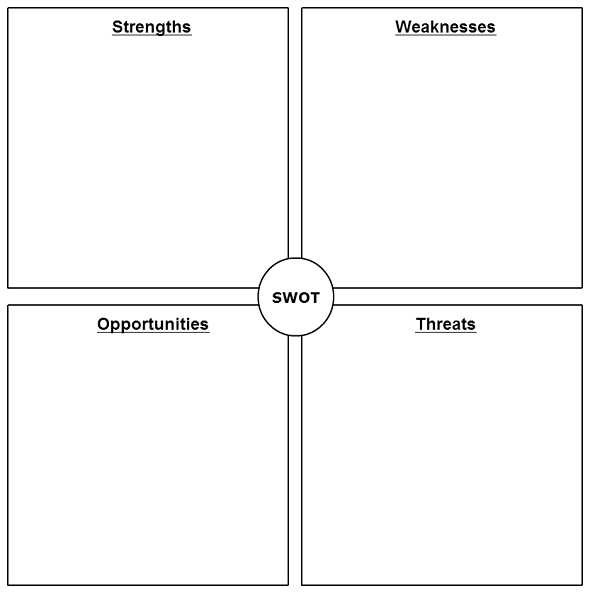Are you stuck at a career crossroads? Struggling to find a career that matches your skill set and salary expectations? Maybe you have an interview coming up or have been thinking about asking your boss for a promotion.
Whatever the reason, a career SWOT analysis can be very beneficial.
Standing for Strengths, Weakness, Opportunities, and Threats, a career SWOT can be used to assess yourself, compare yourself to your peers/competitors, and find career growth opportunities. It’s a simple yet powerful model MBA students use to analyze the strategic positions of companies, products, or business situations.
Getting Started on SWOT
To begin your career SWOT analysis, you’ll need to first consider your strengths, weaknesses, opportunities, and threats, areas often referred to as quadrants.
Below are some examples of each category to help get you started.
Strengths
Strengths, which you have some control over, are your internal, positive attributes, and selling points. Examples include:
- Positive personal traits
- Relevant skills, competencies, knowledge, and work experience
- A solid education
- A strong network
- Commitment, enthusiasm, and passion for your field
Ask yourself:
- What tasks do your colleagues and /or supervisor always delegate to you?
- What are your most notable achievements?
- How do you measure your success?
- What do you like most about your field?
- Do you hold any advanced credentials or supplementary certifications?
Weaknesses
Weaknesses are your internal negative attributes, which, like your strengths, you have control of. Examples include:
- Negative personal characteristics and poor work habits
- A lack of work experience or relevant experience
- A lack of education
- No network or a small one
- A lack of career direction or focus
- Weak professional or career-management skills
Ask yourself:
- With what assignments do you usually require assistance from others?
- When have you received criticism from past clients and/or supervisors?
- What types of tasks do you tend to avoid?
- How would you complete this sentence?
- When _____________________________________, my job performance is negatively impacted?
- Are you missing any credentials frequently required for jobs in your field?
Opportunities
Opportunities are uncontrollable external events you can potentially leverage. Examples include:
- Favorable industry trends
- A booming economy
- A specific job opening
- An upcoming company project
- Emerging demand for a new skill or expertise
- Use of a new technology
- Referral to a high-powered contact
Ask yourself:
- What advancement options exist for your career?
- Are there any new fields or specializations developing in your industry?
- How can you grow your network to include more and/or stronger contacts?
- What career-relevant volunteer opportunities are available?
Threats
Threats are uncontrollable external factors that may work against you and require you to take protective action. Examples include:
- Industry restructuring and consolidation
- Changing market requirements and their impact on your employer
- Changing professional standards that you don’t meet
- Reduced demand for one of your skills
- Evolving technologies you’re unprepared for
- The emergence of a competitor, either to your company or to you personally
- A company decision-maker who does not like or support you
Ask yourself:
- How strong is the competition in your sector?
- What obstacles stand between you and your dream job?
- How do your salary/benefits match up with average compensation for your profession?
- When do you need a new job?
Laying Everything Out
It’s handy to lay the above quadrants out visually in a two-by-two table, with strengths and weakness laid out in the top two boxes and opportunities and threats in the bottom two. You can use a template like the one below or draw one out on paper.

Source: https://creately.com/
Once you have your grid-ready:
- In each quadrant, populate your ideas in a bullet-point form, being as specific as possible.
- Stretch yourself to come up with true insights, taking breaks as needed, to review the content with fresh eyes. Show your analysis to others to get their views and comments.
- Closely edit the work you’ve done, deleting repetitive ideas, and sharpening less specific ones.
- Analyze what it all means to:
- Validate your current position
- Understand the skills, attributes, and experiences you should emphasize and the ones you should downplay
- Brainstorm possible career directions
- Highlight opportunities to take advantage of
- Flag possible threats.
- Determine your four possible actions:
- Strengthening a specific skill or adding something to your strengths quadrant
- Minimizing or eliminating a weakness
- Pursuing or exploiting an opportunity
- Protecting yourself from threats
Don’t forget to revisit and update your career SWOT periodically to add a level of sophistication and effectiveness to your career planning.
Now what?
If you’re using your career SWOT to apply for your dream job(s), you’ll need an amazing cover letter and resume. We can help! For a free 10 minute consultation, call Cathy at 778.878.6210 or fill out the contact form. Our testimonials speak for themselves!
Follow Langley Writing Services on social. Like and follow us on Facebook, LinkedIn, and Instagram, and learn more about getting your cover letter and resume in front of the person who is hiring for the job you want. We offer other professional writing services too! Stay up to date by bookmarking the blog too! Your message, done write!







